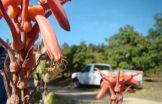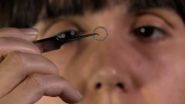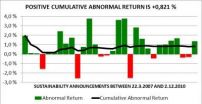(Press-News.org) NARRAGANSETT, R.I. – December 5, 2012 – Scientists have long used the speed of seismic waves traveling through the Earth as a means of learning about the geologic structure beneath the Earth's surface, but the seismic waves they use have typically been generated by earthquakes or man-made explosions. A University of Rhode Island graduate student is using the tiny seismic waves created by ocean waves crashing on shorelines around the world to learn how an underwater plateau was formed 122 million years ago.
"There are any number of ways to create seismic waves, but most people only think about earthquakes and explosions," said Brian Covellone, a doctoral student at the URI Graduate School of Oceanography. "Using data from ocean waves allows you to sample a different region of the Earth's interior than you can from using earthquake data. And by combining multiple data sets, you can get a clearer picture of the geology of the Earth."
Covellone, a native of Warwick, R.I., is investigating the origin of the Ontong Java plateau, an underwater feature north of New Guinea and the Solomon Islands, which formed when a massive volume of magma erupted from the seafloor over a short period of time. Scientists disagree about whether the eruption happened as the result of a plume of magma breaking through the seafloor, in the way that Hawaii was formed, or at a mid-ocean ridge where the Earth's crust was spreading apart and new crust was forming.
According to Covellone, the velocity of seismic waves depends on the temperature and the composition of the material through which it travels. By studying how quickly seismic waves travel near the Ontong Java plateau, scientists can infer how the structure was formed. By analyzing data from hundreds of seismometers around the Pacific Ocean, especially those between Hawaii and Australia, Covellone believes that coastal waves will help provide the answer.
"Earthquake data stands out compared to the background noise of waves crashing on the shoreline," he said. "But that noise has valuable information in it. If you take that noise and sum it up over months or years, they grow in amplitude and you can pull out valuable data from it.
"Waves on a beach excite the Earth in a non-random way, and when I stack all that data together, I get a seismogram that looks like an earthquake, with a large spike in it," he said.
Covellone will present a summary of his research today at a meeting of the American Geophysical Union.
"By the time I graduate, I expect to have a high-resolution image of the velocity structure underneath the Ontong Java plateau," said Covellone. "And from that we'll have an idea of what caused the plateau to form. It will shed a lot of light on the subject, but it's still just one piece of a big puzzle."
### END
URI oceanography student uses crashing waves on shorelines to study Earth's interior
Technique provides insight into ancient formation of underwater plateau
2012-12-05
ELSE PRESS RELEASES FROM THIS DATE:
Wind speeds in southern New England declining inland, remaining steady on coast
2012-12-05
NARRAGANSETT, R.I. – December 5, 2012 – Oceanographers at the University of Rhode Island have analyzed long-term data from several anemometers in southern New England and found that average wind speeds have declined by about 15 percent at inland sites while speeds have remained steady at an offshore site.
Kelly Knorr, a graduate student at the URI Graduate School of Oceanography, and Professor John Merrill reported the results of their research today at the fall meeting of the American Geophysical Union in San Francisco.
The researchers found that average wind speeds ...
Gladstone scientists: 'ApoE is an ideal target for halting progression of Alzheimer's disease'
2012-12-05
SAN FRANCISCO, CA—December 5, 2012—Despite researchers' best efforts, no drug exists that can slow, halt or reverse the onslaught of Alzheimer's disease. A progressive and fatal neurodegenerative disorder, Alzheimer's has stolen the memories and livelihoods of millions—leaving patients and their families struggling to cope with the disease's devastating consequences. But today, scientists at the Gladstone Institutes propose a new research avenue that has the potential to change all that.
In the latest issue of the journal Neuron, available today online, Gladstone Investigators ...
Africa's Homo sapiens were the first techies
2012-12-05
The search for the origin of modern human behaviour and technological advancement among our ancestors in southern Africa some 70 000 years ago, has taken a step closer to firmly establishing Africa, and especially South Africa, as the primary centre for the early development of human behaviour.
A new research paper by renowned Wits University archaeologist, Prof. Christopher Henshilwood, is the first detailed summary of the time periods he and a group of international researchers have been studying in South Africa: namely the Still Bay techno-traditions (c. 75 000 – 70 ...
Discovery of 100 million-year-old regions of DNA shows short cut to crop science advances
2012-12-05
Scientists have discovered 100 million-year-old regions in the DNA of several plant species which could hold secrets about how specific genes are turned 'on' or 'off'.
The findings, which are hoped will accelerate the pace of research into crop science and food security, are detailed by University of Warwick researchers in the journal The Plant Cell.
By running a computational analysis of the genomes of the papaya, poplar, Arabidopsis and grape species, scientists have uncovered hundreds of conserved non-coding sequences which are found in the DNA of all four species.
These ...
Small patches of native plants help boost pollination services in large farms
2012-12-05
A combined team of scientists from Europe and South Africa (Luísa G. Carvalheiro (University of Leeds, UK & Naturalis Biodiversity Research Centre, Netherlands), Colleen Seymour and Ruan Veldtman (SANBI, South Africa) and Sue Nicolson (University of Pretoria)) have discovered that pollinator services of large agriculture fields can be enhanced with a simple cost-effective measure, that involves the creation of small patches of native plants within fruit orchards.
"Mango farmers in South Africa are aware of the pollination limitation of this crop and invest a substantial ...
New technique to deliver stem cell therapy may help damaged eyes regain their sight
2012-12-05
In research published in the journal Acta Biomaterialia, researchers from the University of Sheffield describe a new method for producing membranes to help in the grafting of stem cells onto the eye, mimicking structural features of the eye itself. The technology has been designed to treat damage to the cornea, the transparent layer on the front of the eye, which is one of the major causes of blindness in the world.
Using a combination of techniques known as microstereolithography and electrospinning, the researchers are able to make a disc of biodegradable material which ...
An inadequate diet during pregnancy predisposes the baby to diabetes
2012-12-05
Experts already know that pregnant women should not eat for two. A study now insists on the importance of a healthy diet as a way of avoiding increased insulin and glucose levels in the child, both of which are indicators of diabetes and metabolic syndrome risk.
Maternal diet quality during pregnancy is fundamental to foetal growth as well as insulin and glucose levels at birth. Such indications warn of the possible predisposition to suffer from illnesses like diabetes and metabolic syndrome.
The study was headed by the Complutense University of Madrid and published ...
See-through 'MitoFish' opens a new window on brain diseases
2012-12-05
Scientists have demonstrated a new way to investigate mechanisms at work in Alzheimer's and other neurodegenerative diseases, which also could prove useful in the search for effective drugs. For new insights, they turned to the zebrafish, which is transparent in the early stages of its life. The researchers developed a transgenic variety, the "MitoFish," that enables them to see – within individual neurons of living animals – how brain diseases disturb the transport of mitochondria, the power plants of the cell.
Neurodegenerative diseases such as Alzheimer's, Parkinson's, ...
Sustainable business innovation adds firms' market value
2012-12-05
Sustainable business innovation is good business; researchers from Aalto University, Finland have proved. The researchers tested how sustainability business innovations and the market value of companies in the construction sector are connected. The study is a first of its kind. An event study model was used to analyse large construction sector companies in several European countries as well as Australia.
The most important finding of the study is that a positive and statistically significant association exists between sustainability innovation announcements and the market ...
Creativity and linguistic skills important for immersion in World of Warcraft
2012-12-05
The sense of immersion in role-play and computer games is sometimes viewed as dangerous, as players' strong perceptions of fictional worlds are assumed to make them lose contact with reality. On the other hand, players' immersion also implies a potential for improved learning, since it enables them to 'experience' new places and historical eras. Yet a new study from the University of Gothenburg, Sweden, shows that immersion in online role-play games requires a lot of hard work.
Gaming researcher Jonas Linderoth, at the Department of Education, Communication and Learning, ...
LAST 30 PRESS RELEASES:
Scientists boost cell "powerhouses" to burn more calories
Automatic label checking: The missing step in making reliable medical AI
Low daily alcohol intake linked to 50% heightened mouth cancer risk in India
American Meteorological Society announces Rick Spinrad as 2026 President-Elect
Biomass-based carbon capture spotlighted in newly released global climate webinar recording
Illuminating invisible nano pollutants: advanced bioimaging tracks the full journey of emerging nanoscale contaminants in living systems
How does age affect recovery from spinal cord injury?
Novel AI tool offers prognosis for patients with head and neck cancer
Fathers’ microplastic exposure tied to their children’s metabolic problems
Research validates laboratory model for studying high-grade serous ovarian cancer
SIR 2026 delivers transformative breakthroughs in minimally invasive medicine to improve patient care
Stem Cell Reports most downloaded papers of 2025 highlight the breadth and impact of stem cell research
Oxford-led study estimates NHS spends around 3% of its primary and secondary care budget on the health impacts of heat and cold in England
A researcher’s long quest leads to a smart composite breakthrough
Urban wild bees act as “microbial sensors” of city health.
New study finds where you live affects recovery after a hip fracture
Forecasting the impact of fully automated vehicle adoption on US road traffic injuries
Alcohol-related hospitalizations from 2016 to 2022
Semaglutide and hospitalizations in patients with obesity and established cardiovascular disease
Researchers ‘listen in’ to embryo-mother interactions during implantation using a culture system replicating the womb lining
How changing your diet could help save the world
How to make AI truly scalable and reliable for real-time traffic assignment?
Beyond fragmented markets: A new framework for efficient and stable ride-pooling
Can shape priors make road perception more reliable for autonomous driving?
AI tracks nearly 100 years of aging research, revealing key trends and gaps
Innovative techniques enable Italy’s first imaging of individual trapped atoms
KIER successfully develops Korea-made “calibration thermoelectric module” for measuring thermoelectric device performance
Diversifying US Midwest farming for stability and resilience
Emphasizing immigrants’ deservingness shifts attitudes
Japanese eels, climate change, and river temperature
[Press-News.org] URI oceanography student uses crashing waves on shorelines to study Earth's interiorTechnique provides insight into ancient formation of underwater plateau





